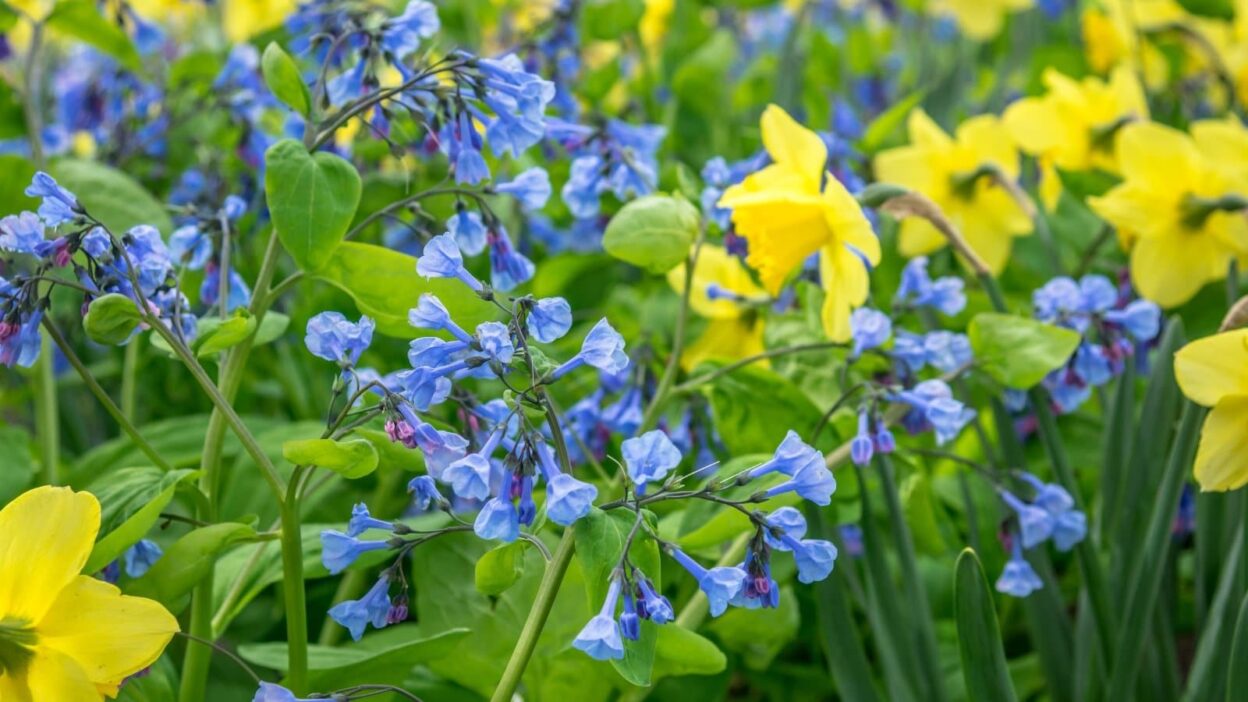Bulbs make it wonderfully easy to coordinate blooms for a well-timed display. With the right flowering time, the options are limitless. As a bonus, bulbs are also easy to plant, even in high numbers, to create an impactful show of color. The dig, scatter, and cover method is hard to beat.
Whether layering bulbs in containers, underplanting shrubs and perennials, or creating a woodland welcome to spring, flowering bulbs are a no-fuss, plant-and-forget reward. Fall is the time to plant spring and summer-flowering bulbs to let them settle in and put down roots before winter.
With overlapping bloom times, you’ll have months of color from bulbs. When pairing, be mindful of early, mid, and late-season bloomers to coordinate the combinations. Otherwise, delight in choosing colors and forms to add a future splash. Stay loose with the planting, aiming for groups in drifts or pockets, depending on your scale. Group bulbs of the same species within the larger arrangement to add heft.
Bluebells and Yellow Daffodils
This sweet duo thrives in an open canopy with spring sunlight. Once leaves emerge on the trees, they tolerate dappled shade during their dormant seasons. Throw in tulips and leucojum for extra interest and a naturalized aesthetic.
Daffodils, with their crisp petals and frilled cups, trumpet the season’s arrival. In hardiness zones 4-8, Narcissus are carefree growers that colonize in the right conditions, producing new bulbs for years. ‘Carlton’ is the golden daffodil we conjure when we picture the blooms. They feature a prominent ruffled cup on one to two-foot stems.
For a double dose of sunshine yellow, opt for ‘Double Cheerfulness’ for a mid-to-late flower. Similarly, ‘Tete-a-tete’ is an early-season daffodil with buttery yellow cups and multiple blooms per stem. It’s one of the first to flower, and the RHS’ Award of Garden Merit winner is a sturdy, floriferous dwarf variety.
English bluebells (Hyacinthoides non-scripta) add a sweet splash of blue violet with their graceful bell flowers. The fragrant blooms suspend from arching stems above dense, leafy crowns for about five weeks in spring and summer. Spanish bluebells (Hyacinthoides hispanica) have lighter blue, larger, unscented flowers.
Virginia bluebells are another great option. These native North American woodland wildflowers have fresh, green foliage and delicate, nodding blue flowers. These and other natives spread slowly through seeds and rhizomes.
Crown Imperial Fritillaria and Grape Hyacinth
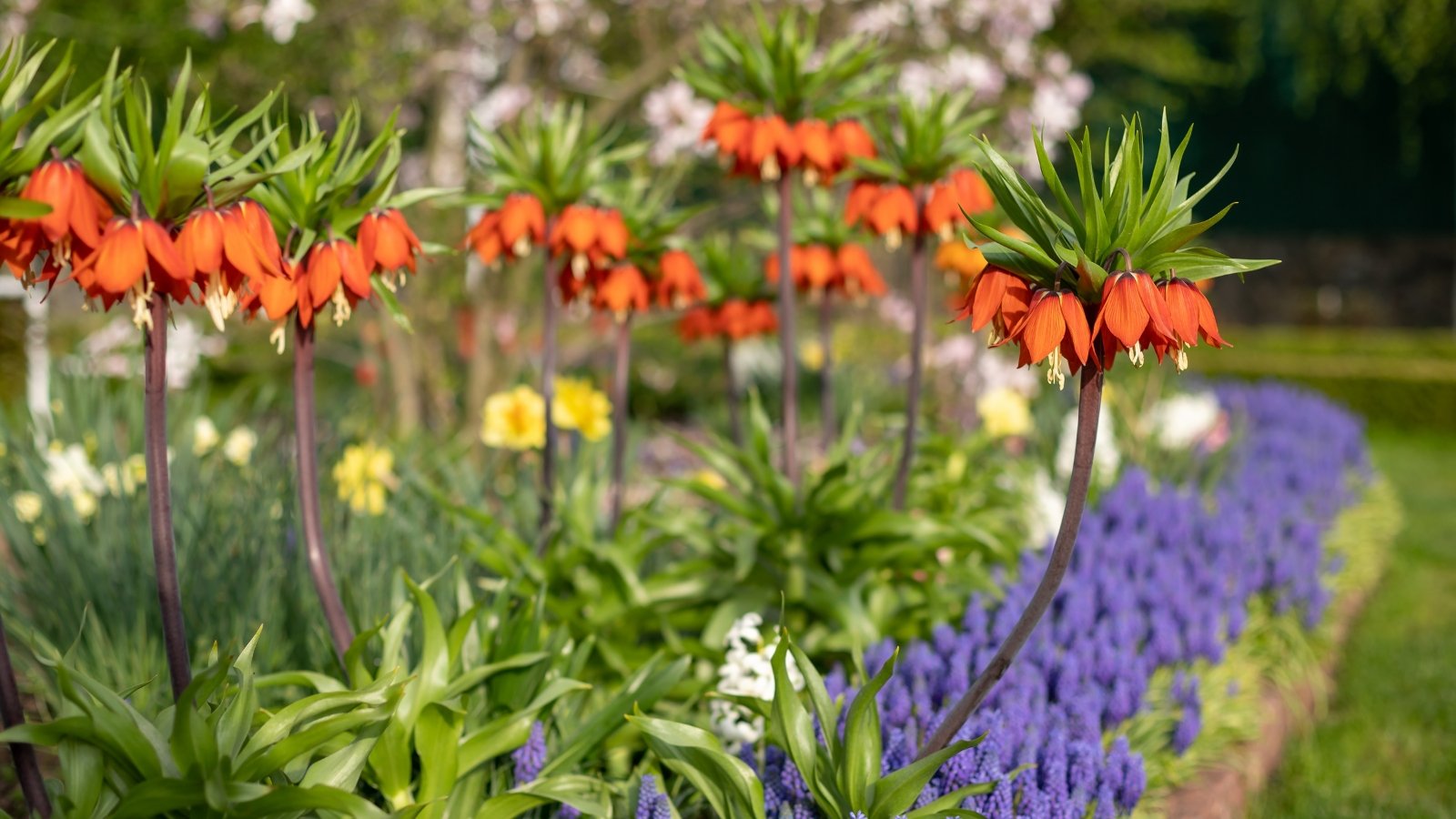
A study in contrasts, both in form and color, low-growing grape hyacinths provide a blanket of blue to the standout crown of the red imperial fritillaria. Add a white-blooming hyacinth for mid-border infill.
Fritillaria is a little-used perennial bulb. A favorite among the genus are the crown imperial cultivars in yellow, orange, and red. The drooping blooms rise on tall, sturdy stems with a flared, leafy crown in glossy green. ‘Rubra Maxima’ has vibrant red-orange flowers and a long bloom time.
Grape hyacinth (Muscari armeniacum) is also a star performer for its front-of-the-border punch, cut flower, and container qualities. It goes with just about any spring-flowering selection. The versatility and durability of the mid-late spring bloomer earned it the Royal Horticultural Society Award of Garden Merit. Tidy clusters of cobalt florets line compact stems, with cultivars in purple and white.
Crocus and Winter Aconite
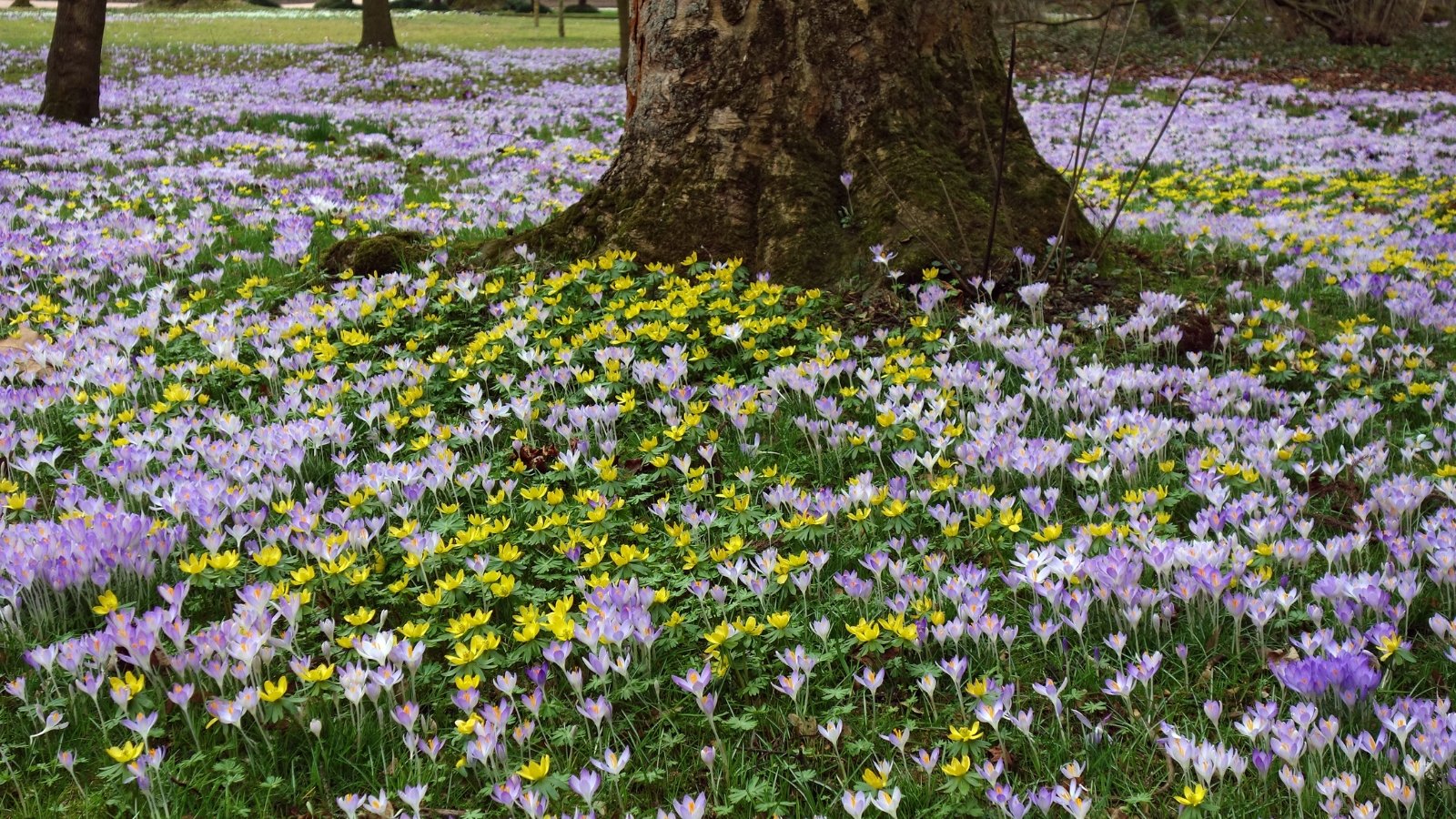
For weeks of cheer and a naturalistic carpet of color, rely on soft blue crocus and gold winter aconite. Whether popping up through snow or brightening chilly afternoons, these are very early-blooming selections that grow in full sun to partial shade and complement snowdrops and glory of the snow. Like many of our other spring-flowering favorites, the foliage of both bulbs goes dormant after flowering and with warming temperatures.
Winter aconite bulbs (actually tubers) have bright yellow buttercup flowers on low stems. Eranthis hyemalis makes the most significant impact when planted close together (two to three inches apart and three inches deep).
Crocus (Crocus vernus) are the tufts of fine blades and cupped blooms that pop up for a few weeks in early spring. Use them in drifts, along walkways, and in grassy areas. The petite flowers open by day and close at night.
Hellebore and Snowdrops
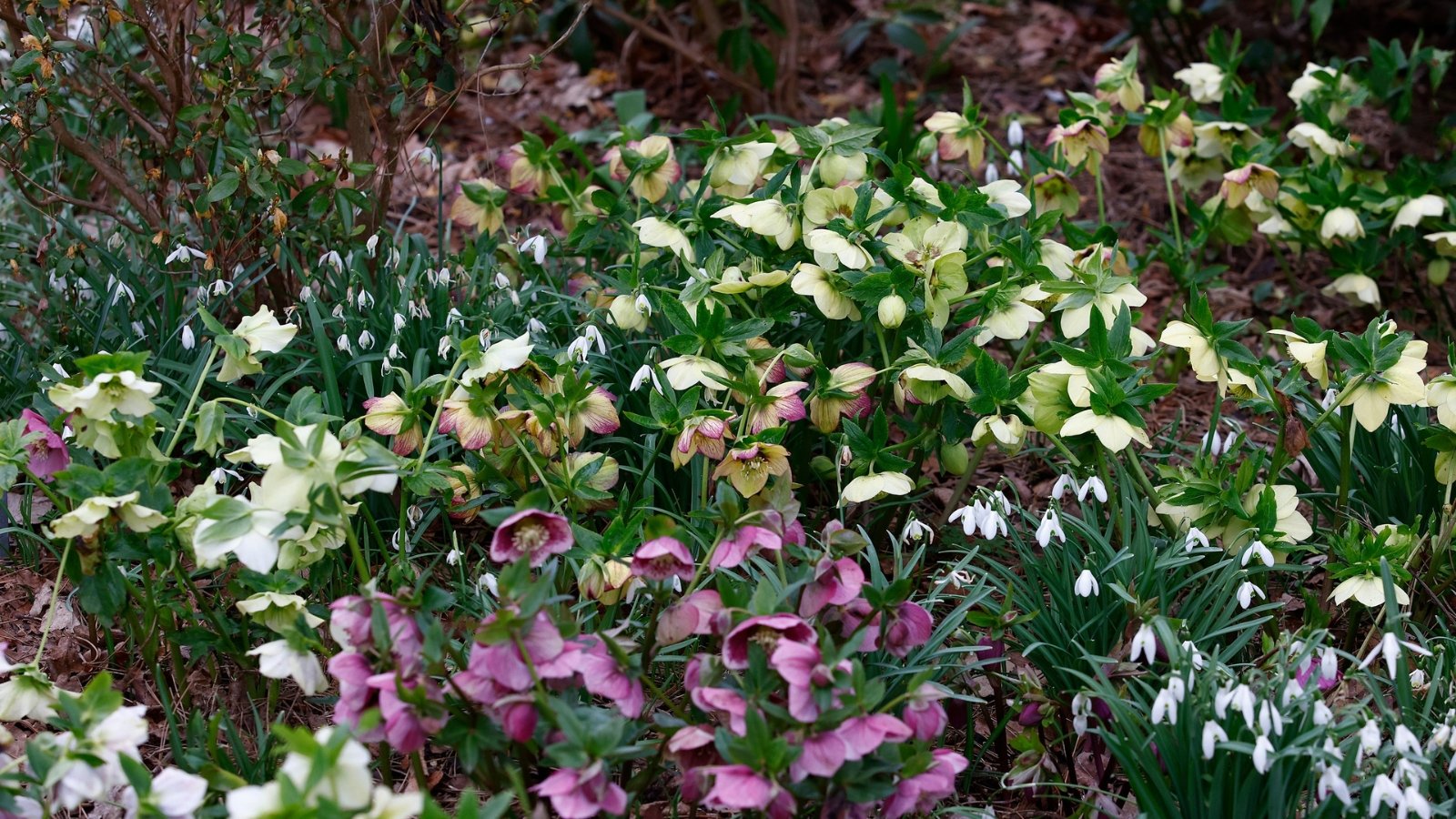
These delicate blooms are beautiful in a mass and spread slowly to form a colony, growing best in consistently moist, average soil and dappled light.
Hellebores (Helleborus spp.) have decorative, nodding blooms and handsome palmate leaves. They bloom in late winter and early spring with exquisite single or double blooms. ‘True Love’ boasts double flowers in deep red maroon. ‘Rome in Red’ is a dusky purple rose. In contrast, an apricot variety like ‘Mother of the Bride’ or creamy yellow ‘Spanish Flare’ would round out this display.
Finally, snowdrops bring crisp white bell-shaped flowers and a light, fresh perfume to the late winter landscape. Often appearing through frosty ground, snowdrops bloom as early as January. Their subtle beauty is ideal for woodlands, naturalized settings, and along pathways.
Hyacinth Blend
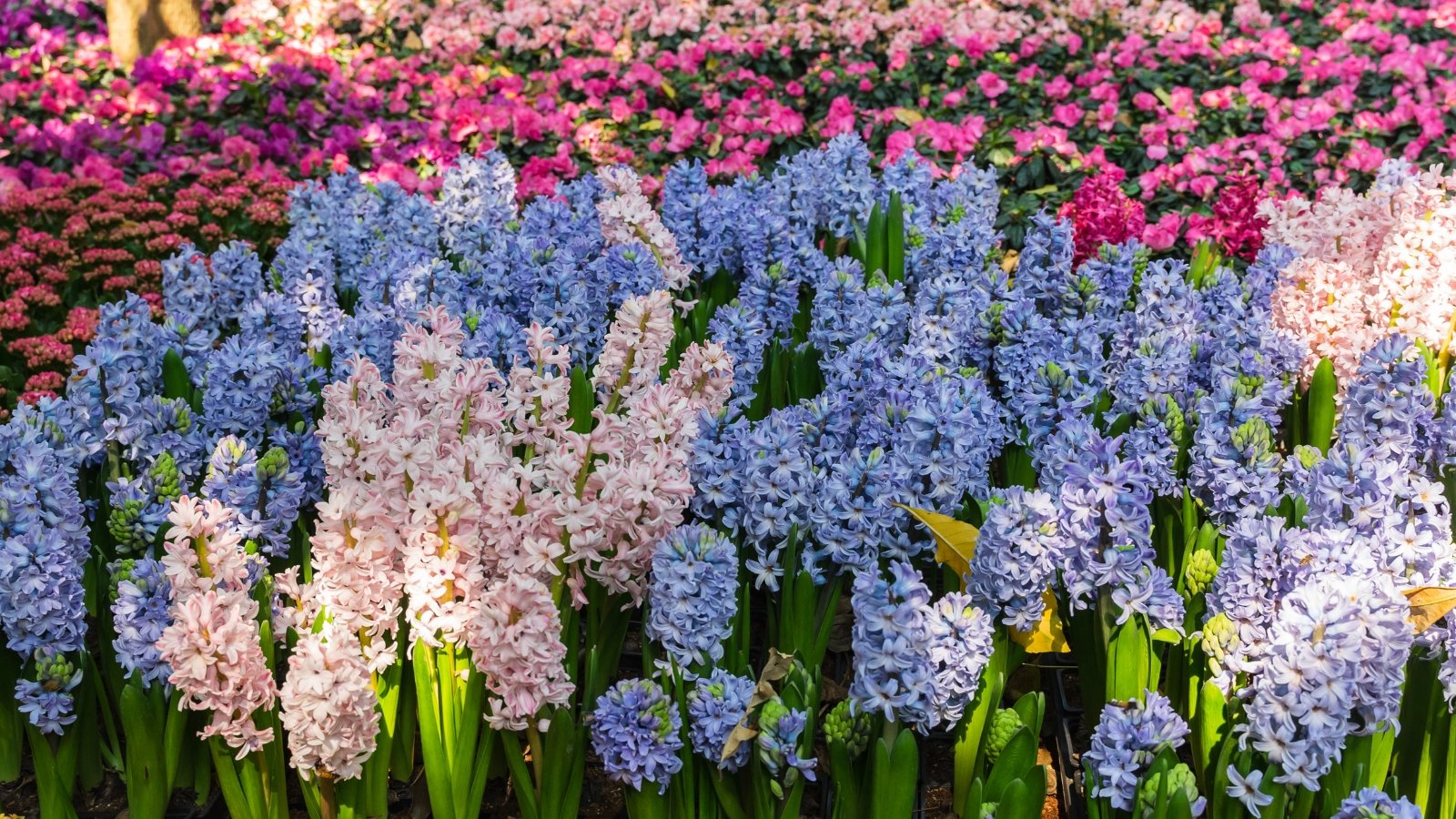
Hyacinths in varying colors make a single-species spectacle (and a cloud of fragrance). They usher in warming temperatures with blooming wands of color and fragrance. Flowers emerge on a single stem in white, pink, lavender, gold, or blue with an intensely sweet perfume.
‘Gypsy Queen’ in peachy blush, ‘Miss Saigon’ and ‘Rubies and Pearls’ in violet magenta, and ‘Delft Blue’ in sky blue make gorgeous understory plantings, naturalizing under tree canopies. Easily divide bulbs to reduce crowding and expand the colony.
Allium ‘Ambassador’ and Peony
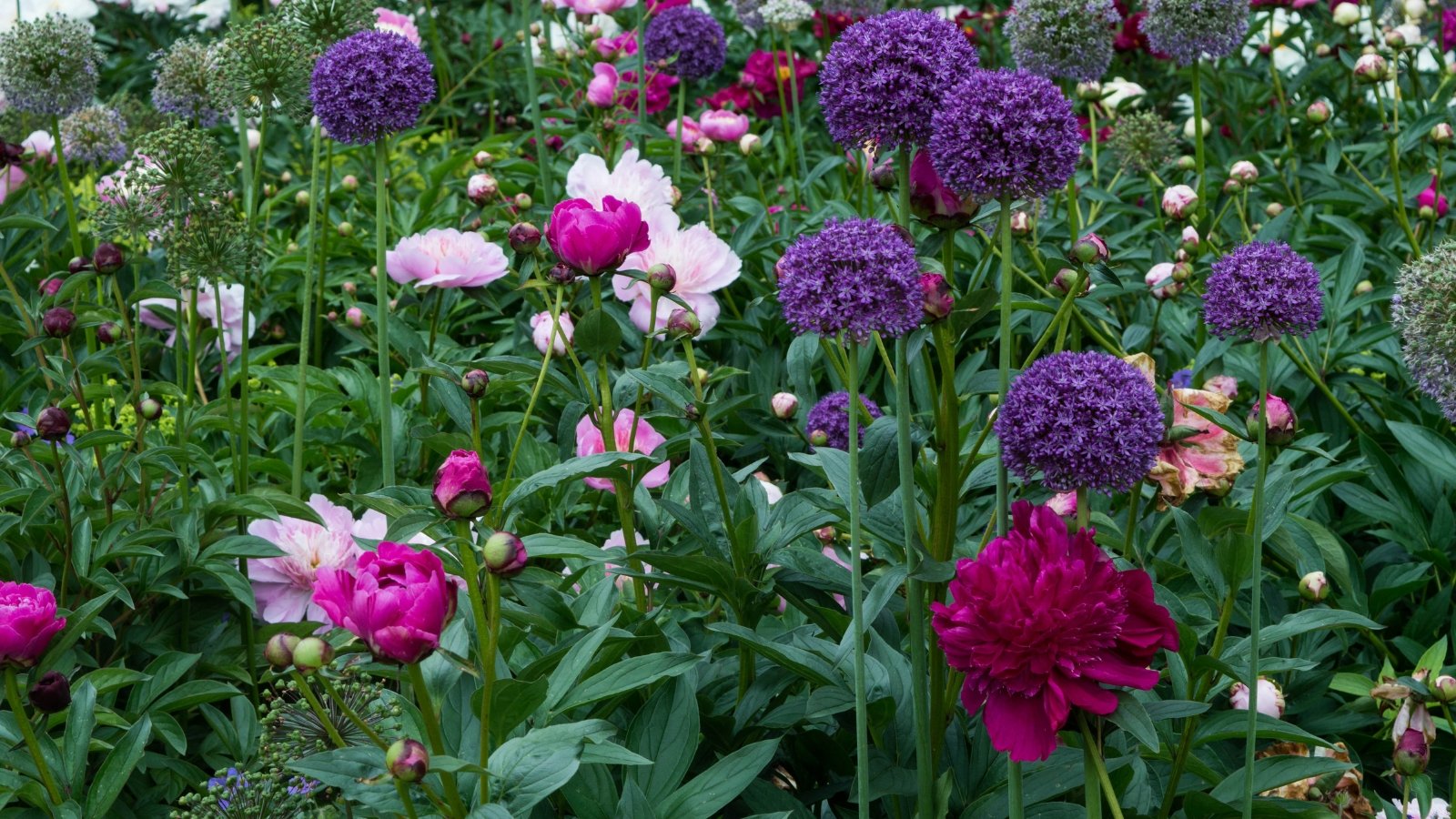
For a duo that exudes early summer charm, opt for a decadent giant allium and peony combo. Giant alliums add structure and reliable style, while peonies bring lush, full blooms and bushy forms. Both complement formal and informal gardens alike.
Giant alliums are easy-to-grow perennials with dramatic flower clusters in spring and early summer. Purple, pink, mauve, lavender, and white globes top tall stems. Long and strappy blue-green leaves emerge in a bundle.
Allium ‘Ambassador’ is a newer giant ornamental cultivar and a recipient of the Award of Garden Merit. The hybrid has showy, impressive orbs that measure 6 inches across on four-foot stems. Deep purple florets pack the full spheres.
Charming peonies (Paeonia) are full-flowered, often semi-double or double, with large, ruffled petals. They bloom once a season, from late spring to early summer. Choosing a few with different bloom times prolongs the seasonal display.
‘Big Ben’ in deep fuchsia has fully double flowers. Similarly, ‘Watermelon Wine’ has tissuey petals in deep magenta and rose with open centers. The bright golden stamens attract pollinators.
‘Parade’ and ‘Golden Parade’ Tulips
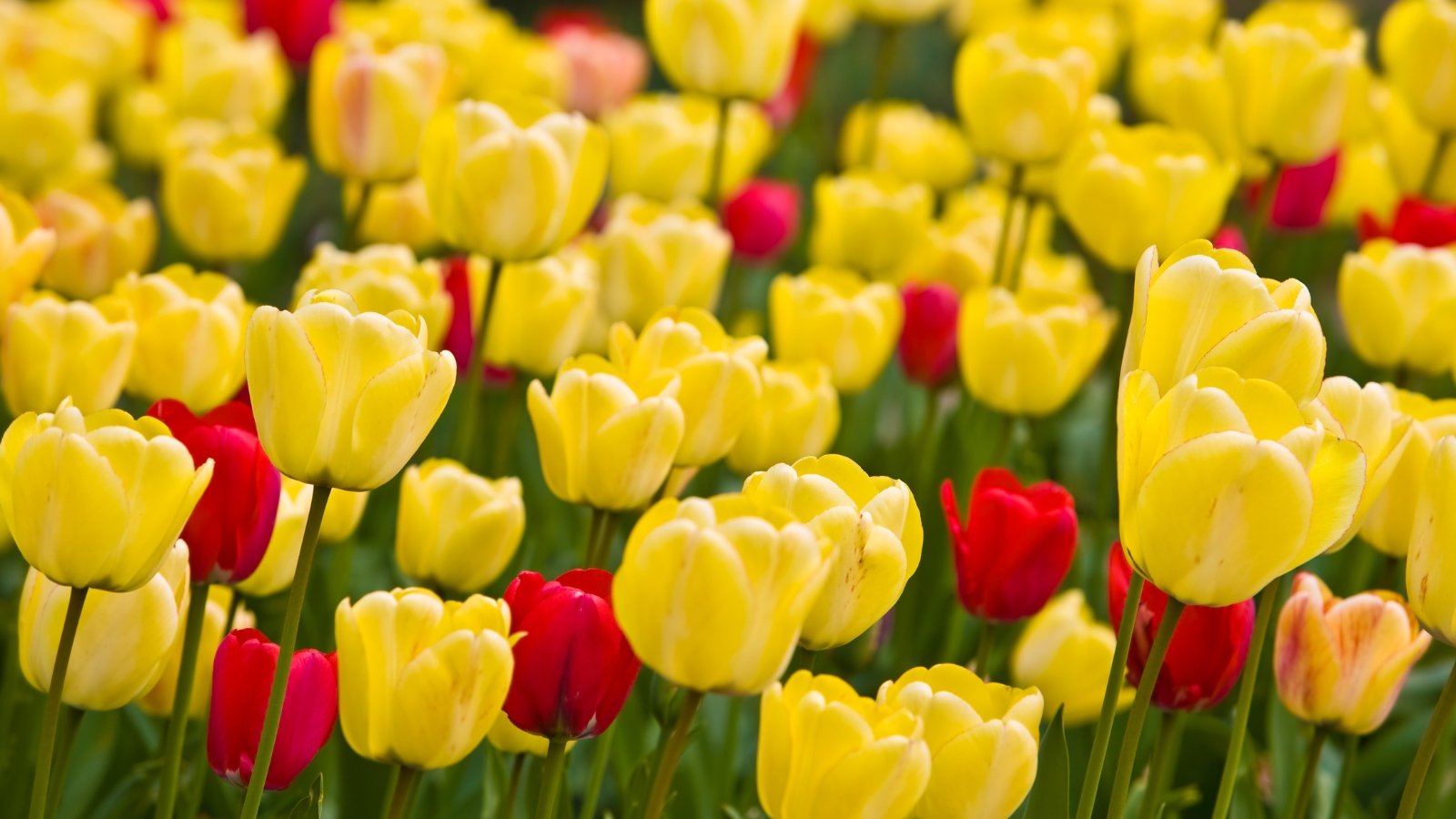
Tulips make a stunning pairing, whether in small groups or en masse. They’re short-lived and bloom for a few years before fading. Because their vigor is best the first year, many gardeners grow tulips as annuals or short-lived perennials.
Darwin hybrids are reliable bloomers across climates, with the most potential to perennialize. The oversized flowers feature perfectly cupped petals and a long bloom time. Their true tulip form is simple and elegant in rich shades and vivid colors.
Large, stately, and on tall stems. ‘Golden Parade’ is clear, sunny yellow. Combined with the bright red ‘Parade,’ this might be the cheeriest spring welcome yet.
Purple and White Fritillaria
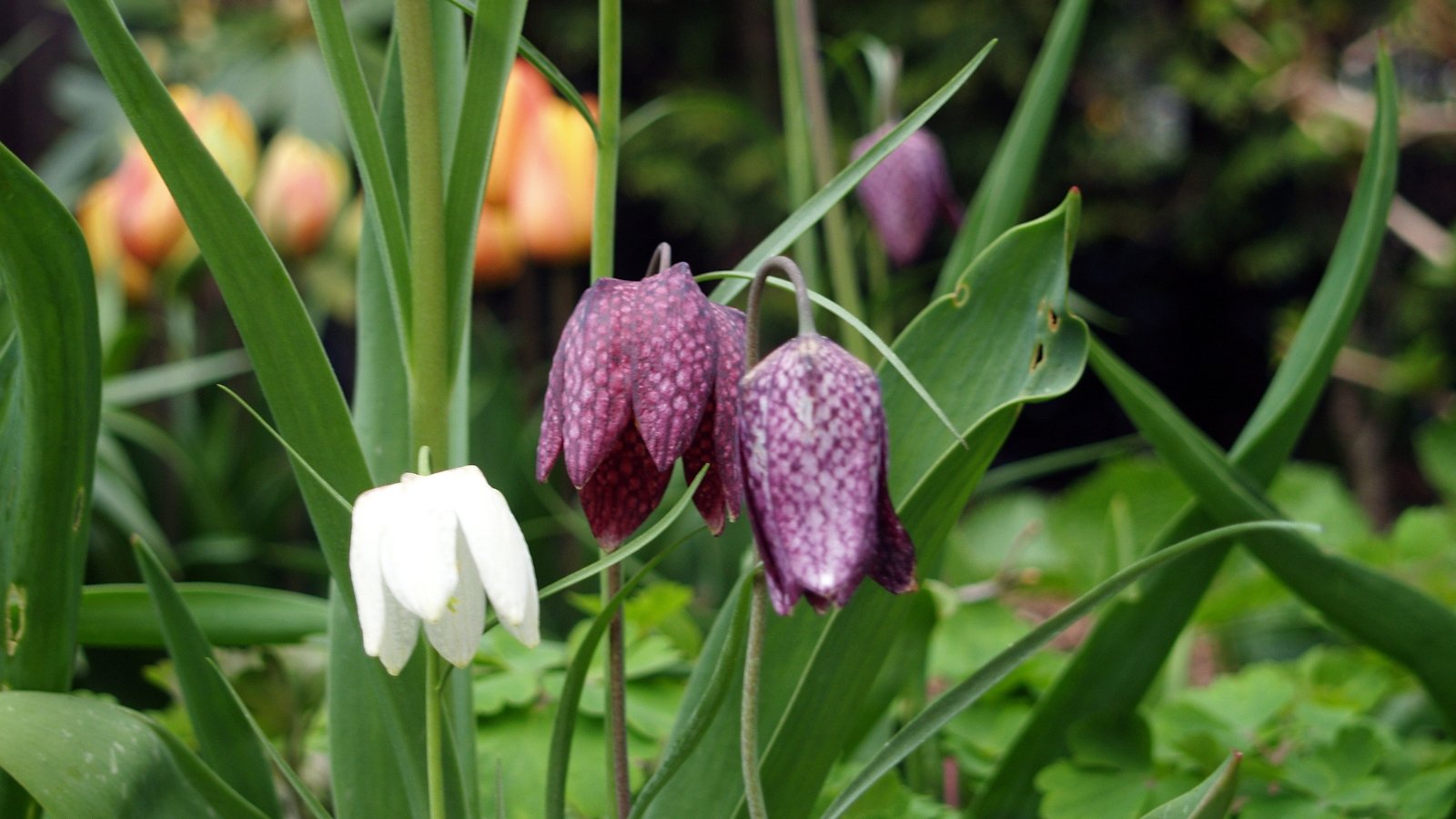
Another single species combination that works perfectly together is purple and white Fritillaria meleagris. The graceful partnership showcases the contrast of delicate stems and pendulous bell blooms in checkered purple and solid white. The subtle beauties make unique borders and naturalized planting additions.
Purple checkered lily represents the species, and ‘Alba’ is a white and faintly checkered award-winning heirloom. Bloom time is around April in their wide-growing range of zones 3 through 8. Complement the arrangement with apricot tulips or daffodils for a delicious contrast.
Anemone ‘Blue Shades’ and Hyacinth ‘Pink Pearl’
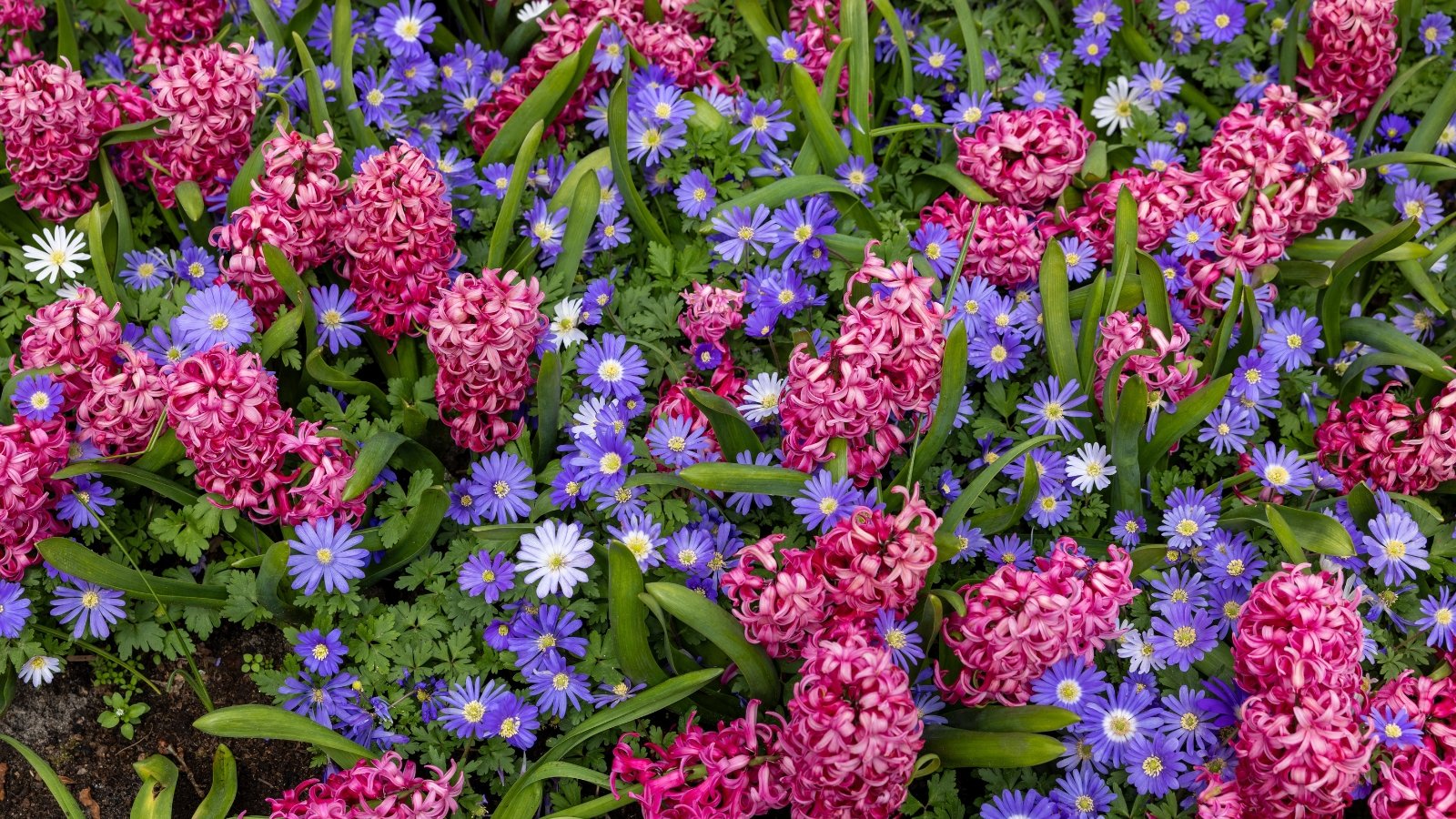
For sweeping color, windflower and hyacinth create a bed full of flowers. Hyacinth orientalis ‘Pink Pearl’ in silvery pink brings soft pastels to the cool blues of windflower.
‘Pink Pearl’ is an heirloom favorite with densely packed flowerheads. Florets have deep rose centers with pinkish-white edges. With a sweet fragrance to match, it has RHS’ Award of Garden Merit status. ‘Carnegie’ in tall, crisp white and ‘City of Haarlem’ in creamy yellow also complement ‘Blue Shades.’
Anemone blanda ‘Blue Shades’ (windflower) yields a carpet of lilac-blue blooms. The clump-forming perennial spreads through seeds and rhizomes to form a ground cover of deep, ferny foliage. Plant the bulbs (tubers) this season within 2-3” of each other for a drift of blooms in April.
Cyclamen and Daffodils
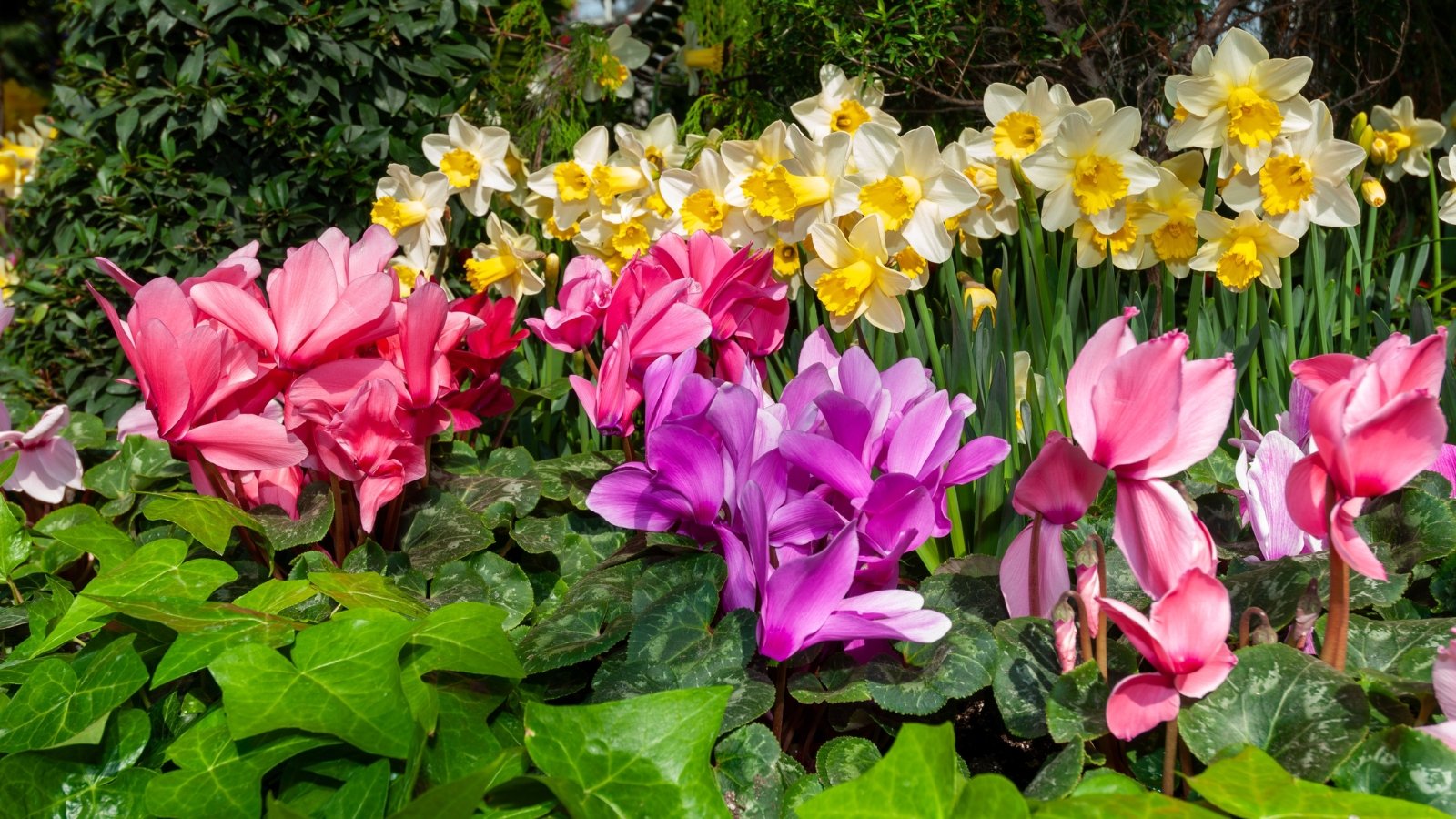
Cyclamen, with mottled, heart-shaped leaves, offer white, pink, purple, red, or bicolor flowers for winter and spring. Cyclamen blooms from November through April, giving months of color and active growing until summer dormancy, when they thrive on neglect.
Hardy cyclamen, Cyclamen hederifolium and Cyclamen coum, perennialize in zone 5 and warmer. They’re smaller relatives of the florist’s cyclamen, C. persicum, which needs protection from cold and hot extremes. C. hederifolium is the hardiest and easiest to grow, with fragrant pink blooms in October and November. C. coum blooms mid-to-late winter with a profusion of pink-purple flowers.
Hardy cyclamen pair best with late-winter bloomers like hellebore, winter aconite, glory of the snow, and snowdrops. Florist types partner with daffodils for a spring kickoff in the ground or containers.
Creamy daffodils provide a bright backdrop. ‘Salome’ is a popular large-cupped variety and an RHS Award of Garden Merit winner. Its solitary flowers have a peachy-yellow cup surrounded by creamy petals. The tall, upright stems are a good fit for the border, container, and vase as cut flowers.
Iris Watercolor Pastels
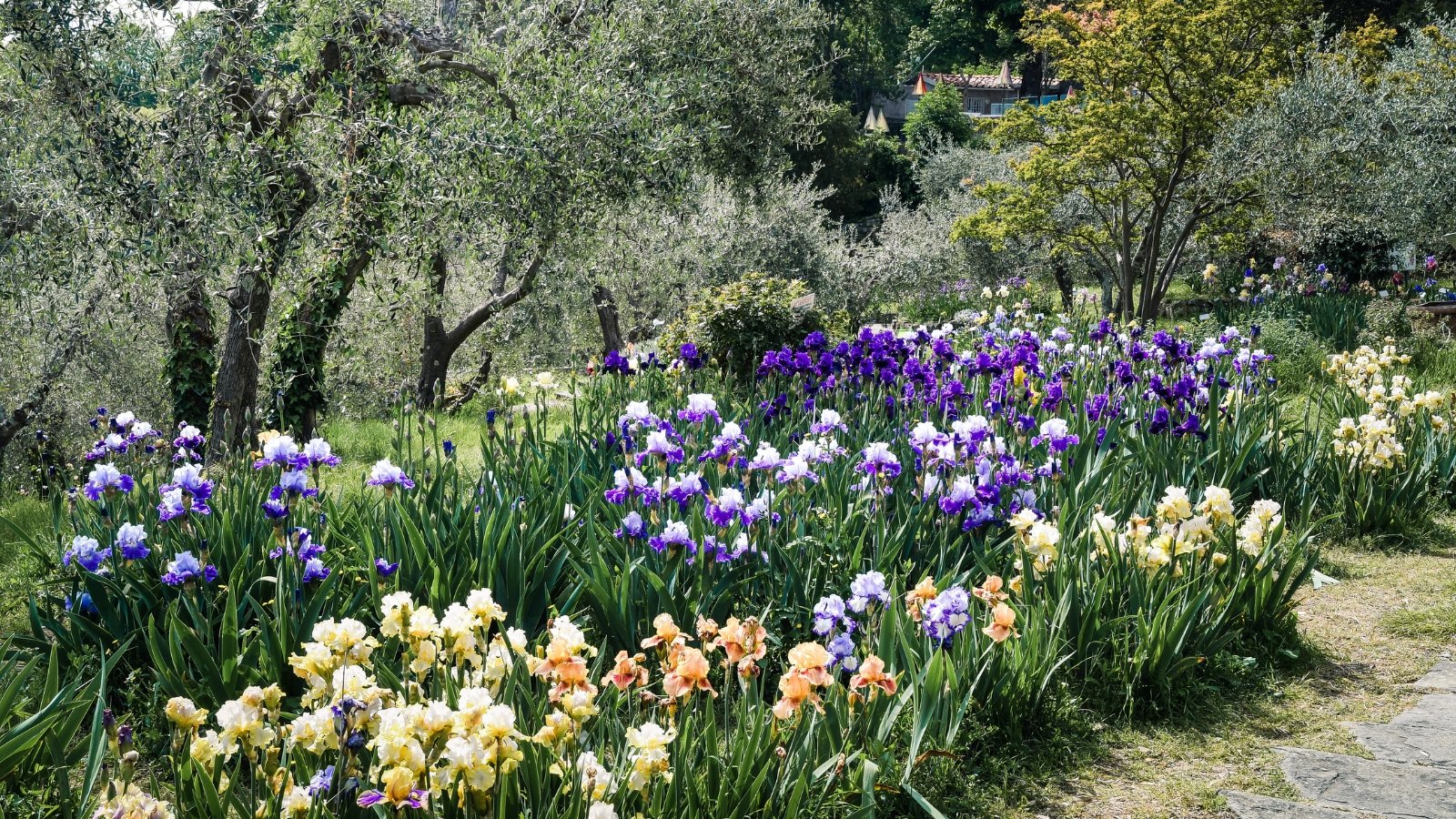
A blend of bearded irises is the stuff of Monet’s Giverny. Arranging them in various heights, shades, and groupings brings order among an inviting, watery wash of pastel shades.
Bearded iris (Iris x germanica) lasts into summer and experiences another flush in the fall. Large, ruffly flowers in a rainbow of colors house frilly petals with three upper standards and three falls (lower petals).
‘Penny Lane’ in soft orange reaches two to three feet, and ‘Maid of Orange’ just one to two. Pair the apricot tones with deep blues and whites. ‘Dusky Challenger’ in royal blue-purple has eight-inch ruffled blooms and a reported chocolate scent. ‘Stairway to Heaven’ brings decadent creamy white standards and denim blue falls. ‘Victoria Falls’ is a lovely pale blue.
Irises divide easily to expand the colony or if crowding reduces vigor. Divide and transplant the rhizomes anytime after flowering until one month before the first anticipated autumn frost.
Foxtail Lily and Allium
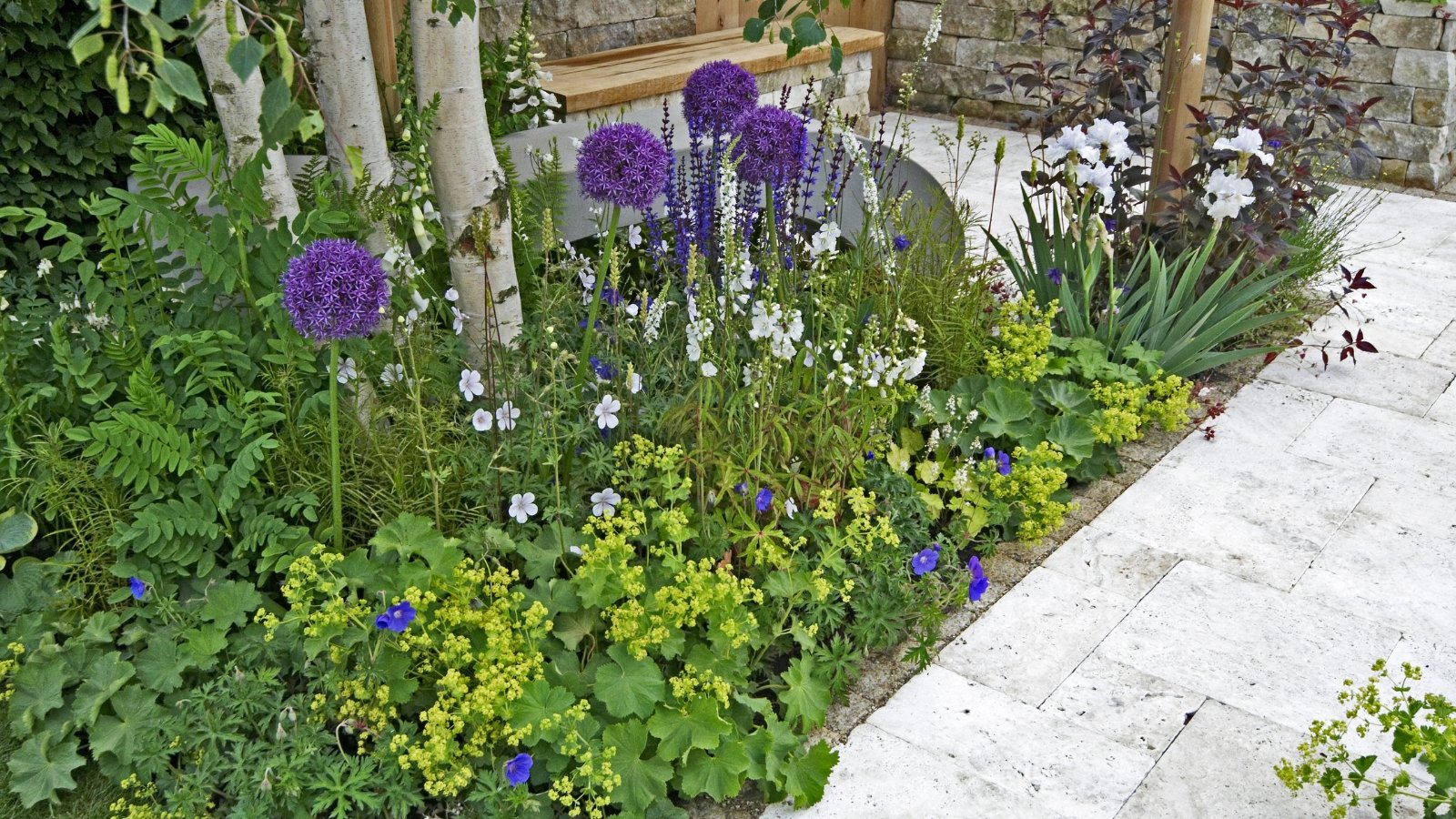
Foxtail lilies and alliums feature dense florets in totally different forms. Foxtail lilies are narrow and bushy, while alliums are globes that range from small pompons to ornamental giants. Hardy in zones 5-8, they’ll benefit from mulch for winter protection in lower zones.
Foxtail lily (Eremurus spp.) is a bulbous perennial with towering bloom spikes in late spring. The tiny flowers comprise bushy foxtail racemes and open from the bottom to the top. The Shelford hybrids represent strong-performing cultivars in pink, orange, white, pink, and yellow.
Allium ‘Purple Sensation’ is popular for its velvety royal purple four- to five-inch spheres that last for weeks of color. This is one of the earliest blooming of the large-flowered varieties with a compact form. Stems reach two to three feet tall.
‘Globemaster’ is a hallmark of giant ornamental alliums with spheres of purple florets that measure 10 inches across. Dense, deep lavender florets have a silvery sheen and as each fades, a new one replaces it for an extended bloom time. After flowering, the petals dry and turn tawny for lasting interest into summer.
‘Globemaster’ is a sterile variety, so reseeding isn’t an issue. The outstanding performer is an RHS Award of Garden Merit recipient.
Camas Lilies and Tulips
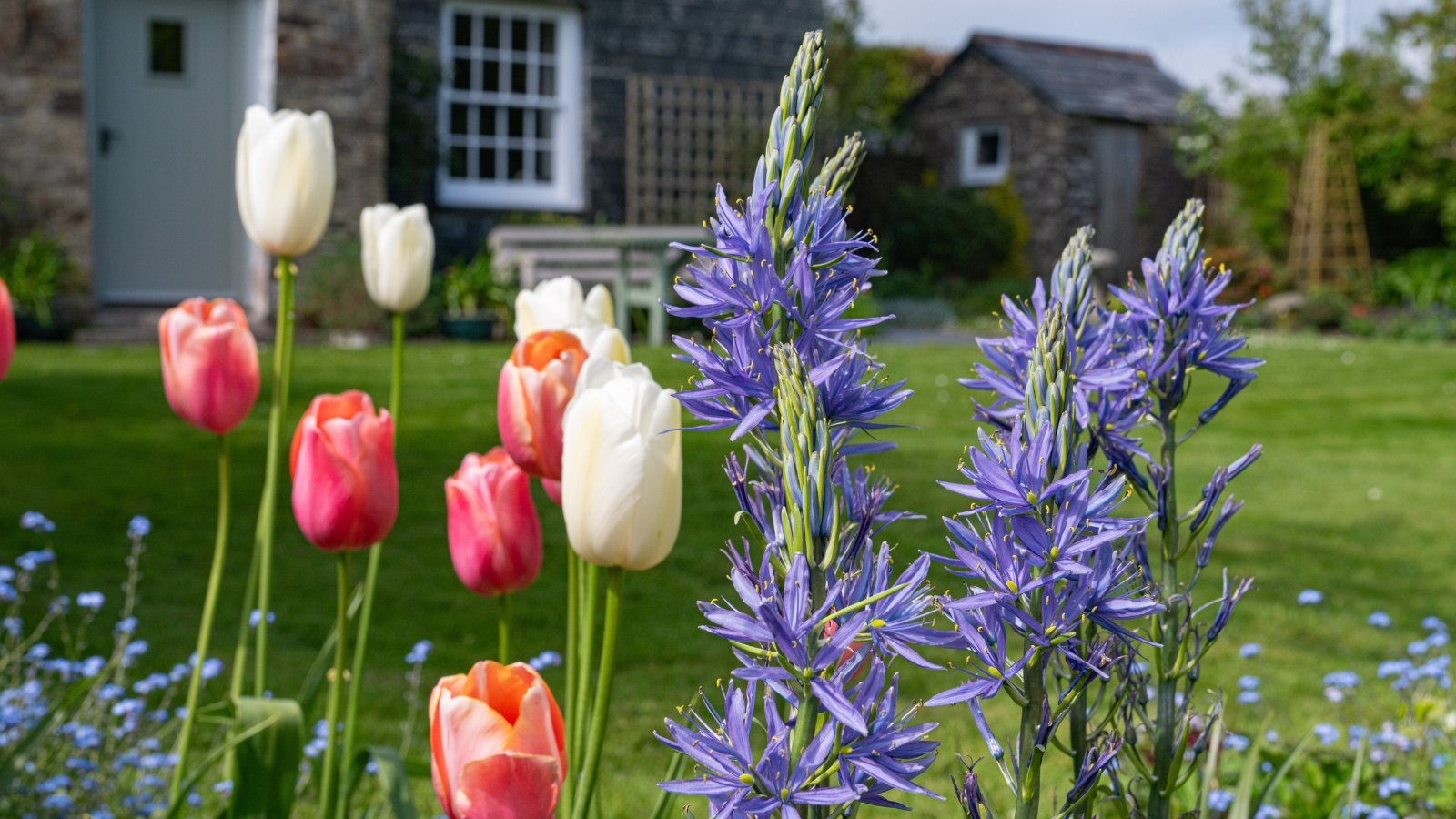
Camas lilies (Camassia) are North American native wildflowers with tall, upright bloom spikes loaded with starry lavender-blue flowers. Flowers open from bottom to top in April and May and make showy cut specimens. They also attract pollinators and naturalize in optimal conditions.
Camas lilies pair perfectly with tulips, daffodils, and alliums. Their periwinkle blooms cool down the display. For a tulip combination, opt for apricot tones like the Darwin ‘Apricot Impression’ or ‘Apricot Beauty.’ They’re gorgeous with crisp white Darwin double ‘Hakuun’ or creamy yellow ‘Secret Perfume’ with double, peony-type petals.

